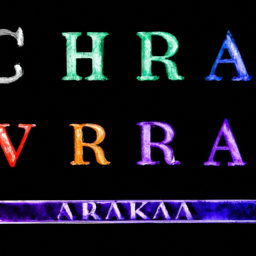
<body>
The History of Chakras
Chakras, the energy centers in our body, have been an integral part of ancient Eastern spiritual practices and are becoming increasingly popular in the Western world as well. These seven spinning disks of energy are believed to play a significant role in physical, emotional, and spiritual well-being. In this article, we will take a deep dive into the history of Chakras and how they have evolved over time.
The Origins of Chakras
The earliest mention of Chakras can be traced back to the ancient Hindu scriptures, known as the Vedas, which were written between 1500 and 1000 BC. The word “Chakra” itself comes from the Sanskrit word for “wheel” or “circle” and refers to the circular shape of these energy centers.
In Hinduism, Chakras are believed to be the meeting points of the subtle energy channels, or nadis, that run throughout the body. There are said to be over 100,000 of these nadis, but seven main ones are considered to be the most important, and they correspond to the seven Chakras.
Chakras in Buddhism
Chakras are also an essential part of Buddhist teachings, with the belief that they are formed by the intersections of the energy channels in the body. In Buddhism, the Chakras are called “cakras” and are considered to be key points along the body’s central channel, which is believed to run from the base of the spine to the crown of the head.
According to Buddhist philosophy, Chakras can either be open or closed, and a balanced opening of all seven is crucial for spiritual enlightenment.
Chakras in Yoga
The concept of Chakras was introduced to the Western world through the practice of Yoga. Yoga, an ancient Indian discipline that focuses on physical, mental, and spiritual well-being, uses Chakras as a way to balance the body’s energy and achieve harmony.
Yogic texts, such as the Yoga Upanishads and Yoga Sutras of Patanjali, describe the Chakras as spinning wheels of energy located along the spine. Each Chakra is associated with a specific color, sound, element, and corresponding physical, emotional, and spiritual attributes.
The Modern Understanding of Chakras
In recent years, there has been a growing interest in Chakras in the Western world, with many people incorporating them into their spiritual practices and healing modalities. While the original Hindu and Buddhist teachings remain the foundation for understanding Chakras, modern interpretations have varied.
Some believe that the Chakras are simply symbols and metaphors for different states of being and do not have any physical existence. Others view them as a more tangible existence, with some even claiming to be able to see and manipulate the Chakra energy through various practices.
The Role of Chakras Today
Whether or not one believes in the physical existence of Chakras, there is no denying their impact on overall well-being. The seven Chakras are thought to influence different aspects of our lives, including physical health, emotional states, and spiritual growth. By balancing and aligning these energy centers, we can achieve a sense of harmony and vitality.
Today, Chakras are utilized in various healing modalities such as Reiki, acupuncture, crystal healing, and meditation. They are also a fundamental concept in many holistic and alternative health practices, emphasizing the mind-body connection and promoting a holistic approach to wellness.
In Conclusion
The history of Chakras is deeply rooted in ancient Eastern spiritual traditions and has evolved over time as these teachings spread to the Western world. While there may be differing interpretations and beliefs about Chakras, their significance in achieving overall well-being cannot be denied. By understanding and working with our Chakras, we can tap into our inner energy and achieve a balanced and harmonious life.
